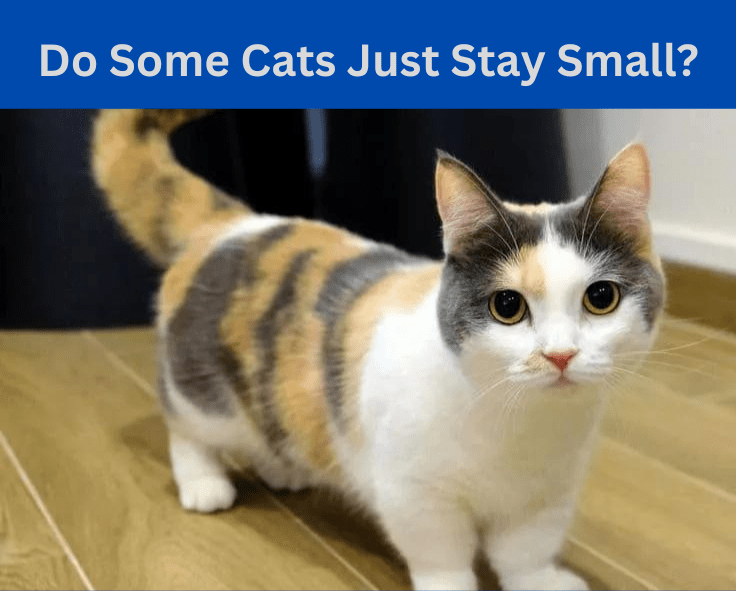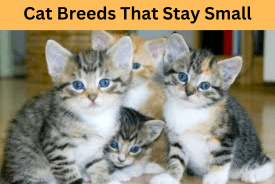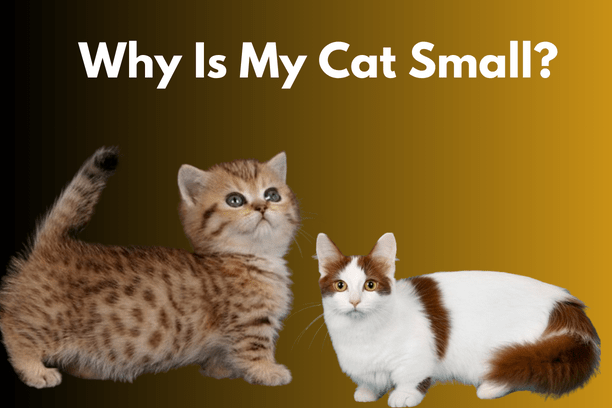Do you have a cat that still looks like a kitten even though he is fully grown? Do you wonder why your cat is small for his age and how you can help him grow bigger? If so, you are not alone. Many cat owners have the same questions like why is my cat small? and concerned about their feline friends?
This article will explain why some cats are small for their age and how to help them grow bigger. We will also discuss the benefits and challenges of having a small cat and how to care for and appreciate them.
Contents
Why Is My Cat Small for His Age?
There are many possible causes of stunted growth in cats, such as genetics, health issues, nutrition, environment, etc. Here are some of the most common ones:
Genetics
Some cats inherit genes that make them smaller than average. This can be due to their breeds, such as the Munchkin, the Singapura, or the Cornish Rex, or random mutations affecting their growth hormones or bone development. Genetic factors are usually not reversible, but they do not affect the cat’s health or lifespan.
Health issues
Some cats may have health problems that prevent them from growing normally, such as parasites, infections, diseases, injuries, or birth defects.
These issues can affect the cat’s appetite, digestion, metabolism, immune system, or organ function.
Health issues can be diagnosed and treated by a veterinarian, and some can be cured or managed with medication, surgery, or therapy.
Nutrition
Some cats may not get enough food or the right kind of food to support their growth. This can be due to poor quality food, insufficient food, food allergies, food intolerance, or picky eating habits.
Nutrition can be improved by providing a balanced and nutritious diet that meets the cat’s age, size, and activity level. Some cats may also benefit from supplements, such as vitamins, minerals, or omega-3 fatty acids, to boost their growth and health.
Environment
Some cats may live in environments that are not conducive to their growth, such as stressful, crowded, dirty, or unsafe places. These environments can affect the cat’s mood, behavior, and hormones, which can affect their growth.
The environment can be improved by providing a comfortable, clean, and stimulating environment that meets the cat’s physical, mental, and emotional needs. Some cats may also need more socialization, play, and exercise to reduce their stress and increase their happiness.
Why is my cat small? there are many possible reasons. Some of them are:
- Your cat’s breed: Some cat breeds are naturally smaller than others, such as the Singapura, the Munchkin, or the Cornish Rex.
- Your cat’s gender: Female cats are usually smaller than male cats.
- Your cat’s age: Cats usually reach their full size by the time they are one year old, but some may grow slower or faster than others.
- Your cat’s nutrition: Cats need a balanced and nutritious diet to support their growth and health. Poor quality food, insufficient food, or food allergies can cause malnutrition or obesity, which can affect your cat’s size.
- Your cat’s health: Cats may have health problems that prevent them from growing normally, such as parasites, infections, diseases, injuries, or birth defects. These issues can affect your cat’s appetite, digestion, metabolism, immune system, or organ function. You should consult your veterinarian if you suspect your cat has any health issues.
Suggested: Cats With Small Heads
How To Care for Your Cross-Eyed Ragdoll Cat
Is It Normal for a Cat to Be Small?
While most cats reach their adult size by the time they are one year old, some cats may be naturally small due to their breed characteristics. For example, the Munchkin cat is known for its short legs, the Singapura cat is known for its petite body, and the Cornish Rex cat is known for its slender frame.
These breeds are not considered to have stunted growth, but rather a unique and distinctive appearance.
According to the Cat Fanciers’ Association (CFA), the average weight of a domestic cat is between 8 and 10 pounds, but some breeds can weigh as little as 4 pounds or as much as 20 pounds.
The average length of a domestic cat is between 18 and 20 inches, but some breeds can be as short as 12 inches or as long as 24 inches. The average height of a domestic cat is between 9 and 10 inches, but some breeds can be as low as 6 inches or as high as 14 inches.
Being small does not necessarily mean being unhealthy or unhappy, as long as the cat is well-cared for and loved. Some small cats may have advantages over larger cats, such as being more agile, adaptable, and cuddly.
However, some small cats may also face challenges, such as being more vulnerable, sensitive, or prone to injuries. Therefore, it is important to monitor and protect your small cat from any potential threats or dangers.
Do Some Cats Just Stay Small?
Some cats may have a slower or shorter growth period than others, depending on their individual development and genetics. This means that some cats may not reach their full size until they are two or three years old, while others may stop growing earlier or later.
This is normal and does not indicate any problem, as long as the cat is healthy and happy. To monitor and measure your cat’s growth, you can use a growth chart, a scale, or a ruler. A growth chart is a tool that shows the average weight and length of cats at different ages and stages.
You can compare your cat’s measurements with the chart to see if he is on track or not. A scale is a device that measures the weight of your cat in pounds or kilograms. You can weigh your cat regularly to see if he is gaining or losing weight. A ruler is a tool that measures the length of your cat in inches or centimeters. You can measure your cat from the tip of his nose to the base of his tail to see if he is growing longer.
However, keep in mind that these tools are only approximate and may not reflect your cat’s true size or growth. Some cats may have more or less muscle, fat, or fur than others, which can affect their weight and length.
Some cats may also have different body shapes and proportions than others, which can affect their appearance and perception. Therefore, the best way to assess your cat’s growth is to observe his overall health, behavior, and happiness.

How Can I Make My Cat Bigger?
If you want to help your cat grow bigger, the best way to do so is to provide a balanced and nutritious diet, adequate exercise, and a stimulating environment. Here are some tips on how to do that:
Diet
Provide your cat with high-quality cat food that meets his age, size, and activity level. Choose food that is rich in protein, fat, and calories, as these are essential for growth and energy.
Avoid food that is low in quality, quantity, or variety, as these can cause malnutrition, boredom, or obesity.
You can also consult your veterinarian for specific recommendations or prescriptions for your cat’s diet.
Some cats may also benefit from supplements, such as vitamins, minerals, or omega-3 fatty acids, to boost their growth and health. However, do not overfeed or over-supplement your cat, as this can cause health problems, such as diabetes, kidney disease, or liver disease.
Exercise
Provide your cat with enough physical activity to keep him fit, strong, and healthy. Choose activities that are suitable for his age, size, and personality, such as playing, chasing, jumping, or climbing.
Avoid activities that are too strenuous, risky, or boring, as these can cause injury, stress, or depression. You can also use toys, such as balls, feathers, or lasers, to make the exercise more fun and engaging. However, do not force or overexert your cat, as this can cause exhaustion, pain, or resentment.
Environment
Provide your cat with a comfortable, clean, and stimulating environment that meets his physical, mental, and emotional needs. Choose a place that is spacious, safe, and cozy, such as a bed, a couch, or a crate.
Avoid a place that is cramped, dirty, or noisy, as these can cause discomfort, infection, or anxiety. You can also use items, such as scratching posts, catnip, or music, to make the environment more appealing and relaxing. However, do not isolate or confine your cat, as this can cause loneliness, boredom, or aggression.
Cat Breeds That Stay Small
Some common cat breeds that stay small are:
- Singapura: This is the smallest cat breed, weighing only 4 to 8 pounds. They have large eyes and ears and a brown-ticked coat.
- Munchkin: This breed has very short legs due to a genetic mutation, making them stand only 7 to 9 inches tall at the shoulder. They are playful and friendly cats.
- Cornish Rex: This breed has a slender body and a curly coat. They weigh between 6 and 10 pounds and have a high energy level.
- Devon Rex: This breed is similar to the Cornish Rex, but has a more triangular head and larger ears. They weigh between 5 and 10 pounds and are affectionate and intelligent cats.

Conclusion
Some cat owners are curious and ask why is my cat small? cat size is determined by many factors, such as genetics, health, nutrition, environment, and more.
Some cats are small for their age due to natural or unnatural causes, while others are small due to their breed or individual characteristics. Small cats can be healthy and happy, as long as they are well-cared for and loved.
However, small cats can also face challenges, such as being vulnerable, sensitive, or prone to injuries. If you want to help your cat grow bigger, you can provide a balanced and nutritious diet, adequate exercise, and a stimulating environment.
However, you should not overfeed, over-supplement, or force your cat to grow beyond its natural potential, as this can cause health problems, such as diabetes, kidney disease, or liver disease.
FAQs: why is my cat small?
Q: What is the average size of a cat?
- A: The average size of a cat can vary depending on the breed, gender, and age of the cat. According to the Cat Fanciers’ Association (CFA), the average weight of a domestic cat is between 8 and 10 pounds, and the average length is between 18 and 20 inches.
Q: How can I tell if my cat is small for his age?
- A: You can tell if your cat is small for his age by comparing his measurements with a growth chart, a scale, or a ruler. A growth chart shows the average weight and length of cats at different ages and stages. A scale measures the weight of your cat in pounds or kilograms. A ruler measures the length of your cat in inches or centimeters. However, these tools are only approximate and may not reflect your cat’s true size or growth. The best way to assess your cat’s growth is to observe his overall health, behavior, and happiness.
Q: What are some common causes of stunted growth in cats?
- A: Some common causes of stunted growth in cats are genetics, health issues, nutrition, and environment. Genetics can make some cats smaller than average due to their breed or random mutations. Health issues can prevent some cats from growing normally due to parasites, infections, diseases, injuries, or birth defects. Nutrition can affect some cats’ growth due to poor quality food, insufficient food, food allergies, food intolerance, or picky eating habits. The environment can influence some cats’ growth due to stressful, crowded, dirty, or unsafe places.
Q: How can I help my cat grow bigger?
- A: The best way to help your cat grow bigger is to provide a balanced and nutritious diet, adequate exercise, and a stimulating environment. You should provide your cat with high-quality cat food that meets his age, size, and activity level. You should also consult your veterinarian for specific recommendations or prescriptions for your cat’s diet. Some cats may benefit from supplements, such as vitamins, minerals, or omega-3 fatty acids, to boost their growth and health. You should also provide your cat with enough physical activity to keep him fit, strong, and healthy. You should choose activities that are suitable for his age, size, and personality, such as playing, chasing, jumping, or climbing. You should also use toys, such as balls, feathers, or lasers, to make the exercise more fun and engaging. You should also provide your cat with a comfortable, clean, and stimulating environment that meets his physical, mental, and emotional needs. You should choose a place that is spacious, safe, and cozy, such as a bed, a couch, or a crate. You should also use items, such as scratching posts, catnip, or music, to make the environment more appealing and relaxing. You should also give your cat enough socialization, play, and exercise to reduce his stress and increase his happiness.
Q: Is it normal for a cat to be small?
- A: Yes, it is normal for a cat to be small if it is due to its breed, gender, or individual characteristics. Some cat breeds are naturally small, such as the Singapura, the Munchkin, or the Cornish Rex. Female cats are usually smaller than male cats. Some cats may have a slower or shorter growth period than others, depending on their individual development and genetics. Being small does not necessarily mean being unhealthy or unhappy, as long as the cat is well-cared for and loved. Some small cats may have advantages over larger cats, such as being more agile, adaptable, and cuddly. However, some small cats may also face challenges, such as being more vulnerable, sensitive, or prone to injuries. Therefore, it is important to monitor and protect your small cat from any potential threats or dangers.




